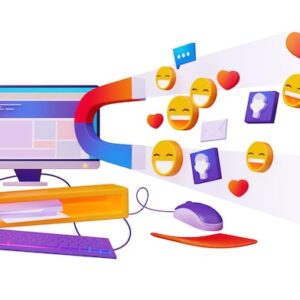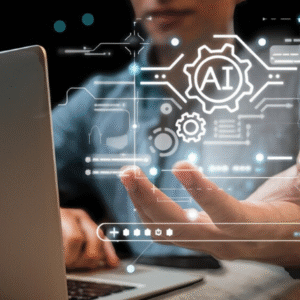In a world where artificial intelligence is transforming content creation, communication, and decision-making, the need for authenticity is more important than ever. AI detector—and their German equivalent, KI detectors (Künstliche Intelligenz Detektoren)—have emerged as essential tools in identifying whether content has been generated by humans or machines.
What Is an AI Detector?
An AI detector is a software tool that determines whether a piece of content—such as text, images, or audio—was generated by artificial intelligence. These detectors are designed to assess the likelihood that content was produced by a machine learning model, such as ChatGPT, Google Gemini, or other large language models (LLMs).
In German-speaking regions, the term “KI Detector” (short for “Künstliche Intelligenz”) is used. While the terminology differs, both AI detectors and KI detectors perform the same fundamental function: distinguishing between human and machine-generated content.
Why Are AI and KI Detectors Important?
The explosion of generative AI tools has raised concerns across multiple sectors. The ability to generate realistic, high-quality content at scale can lead to:
-
Academic dishonesty
-
Misinformation and fake news
-
Plagiarism
-
Job application fraud
-
Automated spam content
AI and KI detectors help address these challenges by offering transparency, promoting trust, and safeguarding originality. Whether in schools, businesses, or digital platforms, these detectors are essential in upholding content integrity.
How AI and KI Detectors Work
AI and KI detectors use a mix of statistical, linguistic, and machine learning techniques to identify signs of artificial generation. Some of the most common detection techniques include:
Perplexity and Burstiness
-
Perplexity measures how predictable a text is. AI-generated content typically has low perplexity, meaning it is more predictable.
-
Burstiness refers to the variation in sentence lengths and structures. Human writing tends to have higher burstiness.
Linguistic Patterns
AI detectors look for repeated patterns in sentence structure, vocabulary, tone, and coherence that are common in machine-generated outputs.
AI Fingerprints
Advanced detectors can identify subtle traces of specific AI models in the content. These might include phrasing tendencies or syntax patterns unique to models like GPT or Claude.
Probability Scores
Most AI/KI detectors provide a probability score, such as “80% likely AI-generated,” giving users a scale rather than a binary result.
Top Use Cases for AI and KI Detectors
Education
Teachers and schools use AI detectors to check whether students have submitted work written by AI. This helps uphold academic integrity and ensures fair assessment.
Publishing and Journalism
Editors and content managers verify if articles, essays, or reports were produced organically or by machines, ensuring journalistic credibility.
Human Resources
Employers use KI detectors to evaluate resumes, cover letters, and writing samples, identifying whether candidates used AI to generate their materials.
Marketing and SEO
Content marketing teams rely on AI detectors to assess whether content is original and meets quality standards for SEO.
Legal and Government
Legal teams and regulatory bodies may use KI detectors to verify the authenticity of testimonies, reports, or documents, particularly when credibility is critical.
Popular AI and KI Detectors in 2025
Several AI/KI detectors have gained popularity for their accuracy and user-friendly features:
GPTZero
Originally built for educational institutions, GPTZero is now widely used for general AI content detection. It provides sentence-level analysis and batch scanning.
ZeroGPT
ZeroGPT is a multilingual detector that supports English, German, Spanish, and more. It is ideal for global businesses and academic institutions.
Content at Scale AI Detector
Used primarily in digital marketing, this detector identifies AI-generated blog posts, landing pages, and other marketing materials.
Writer AI Content Detector
This tool is designed for professional writers and editors, helping them identify whether content has been generated with AI assistance.
CrossPlag AI Content Detector
With an emphasis on plagiarism and AI detection, this tool is ideal for universities and professional institutions in need of comprehensive review.
Limitations of AI and KI Detectors
While AI detectors are powerful, they are not infallible. Here are some of the major limitations:
False Positives
Sometimes, human-written content is incorrectly flagged as AI-generated. This can occur if the writing is overly structured, lacks variation, or mimics AI phrasing.
False Negatives
Highly advanced AI models may produce content that is indistinguishable from human writing. Detectors may fail to identify such content correctly.
Language Constraints
Most AI/KI detectors are optimized for English. Although some support other languages like German, French, or Spanish, their accuracy can drop with complex grammar or local dialects.
Rapid AI Evolution
Generative models are evolving rapidly. Detectors must continuously update their algorithms to stay effective against new AI capabilities.
Ethical and Legal Considerations
The widespread use of AI and KI detectors also raises ethical questions.
Privacy Concerns
Submitting personal documents to an AI detector may compromise data privacy. Detectors should follow strict data protection guidelines.
Due Process
False positives can harm students or professionals. Institutions should have an appeal process before penalizing individuals based on AI detection alone.
Transparency
Organizations using detectors should disclose their use. Secret detection can damage trust between employees, students, and institutions.
Bias and Fairness
Detectors may be biased against non-native speakers or writers with unique styles. Developers must continually test and refine these tools for fairness.
The Future of AI and KI Detection
As AI becomes more embedded in daily life, AI and KI detection will evolve into an even more critical field. Here’s what the future may look like:
Real-Time Detection
Detectors may soon be integrated into writing platforms like Google Docs, Microsoft Word, or messaging apps to flag AI-written content in real time.
Multimodal Detection
Future detectors will analyze not just text but also AI-generated images, videos, audio, and even code to ensure authenticity across all media.
Blockchain Verification
Decentralized systems may be used to digitally watermark human-authored content, offering a permanent proof of authenticity.
Cross-Language Adaptation
Next-generation KI detectors will offer improved support for multiple languages, including German, French, Arabic, Chinese, and more, to meet global demand.
How to Choose the Right AI/KI Detector
When selecting a detector for personal or organizational use, consider the following:
-
Accuracy: Choose tools with a strong track record and scientific validation.
-
Language Support: Ensure the detector works effectively in your primary language.
-
Privacy Policy: Opt for tools that prioritize user privacy and data security.
-
Features: Look for features like sentence-level analysis, batch upload, and integration with existing platforms.
-
Support and Updates: Choose providers that actively maintain and update their detection algorithms.
Conclusion
AI and KI detectors play a vital role in a world flooded with synthetic content. As artificial intelligence continues to redefine how we create and communicate, detectors ensure that truth, originality, and authenticity remain intact. Whether you’re a teacher, business owner, journalist, or software developer, these tools offer peace of mind and uphold the standards of human expression.
Check out new and latest article to see by clicking here.




